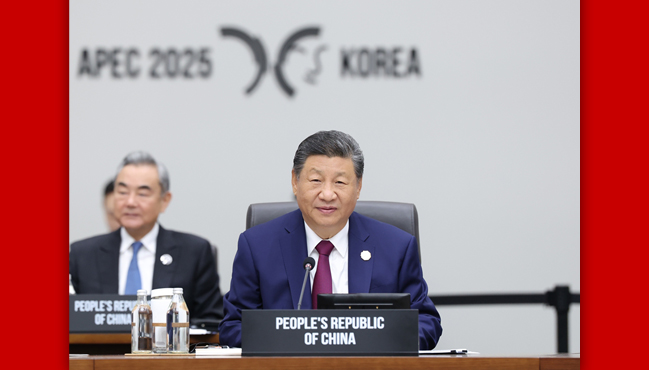
站内搜索
|
The Dalai Lama “retired” more than a year ago. For more than a year, he has been going all over the globe announcing that he has already turned political power over to an “elected political leader”, and expressing deep repentance for his deep involvement in politics over the past several decades, saying, “For many years I have said time and again that religious and political leadership should be separated, but all the while I have been both a religious and political leader. My actions have not conformed to my words, and this is hypocritical”. He even went so far as to swear, “For the rest of my life, I will not be involved in politics and will devote myself to following Buddha”. Is it possible for a person who has for decades been the head of separatist political clique fighting for “Tibetan independence” to genuinely completely cut himself off from his political clique and its separatist activities? Let’s let the facts speak for themselves. First, let us look at the political position laid out for the Dalai Lama in the Dalai Lama clique’s “revised constitution”. At the same time the Dalai Lama announced he was retiring in March of last year, he pretentiously asked that the constitution of the “government in exile” be revises to eliminate from it “all reference to the Dalai Lama in the political and administrative work of the government”. However, this “constitution”, which was approved by the Dalai Lama, not only did not in the slightest reduce the Dalai Lama’s political power, but on the contrary further concentrated and strengthened it. At the outset, this “constitution” stated, “The Fourteenth Dalai Lama is the supreme leader and teacher of the Tibetan people”, and also specified that after he “retired”, he would still enjoy three kinds of constitutional powers. First, “Concerning safeguarding and developing the wellbeing of the people and their moral character and religious culture, and solving the ‘Tibet question’ ,[the Dalai Lama] has the responsible to provide guidance, teaching and encouragement”. The Dalai Lama habitually uses the term “Tibet question” in the sense of the “question of the genuine autonomy for the six million Tibetan people”. This is clearly not a moral or religious issue, but is entirely a political issue. Second, the Dalai Lama “can of his own initiative or at the request of others give guidance to the legislature or Kashag on matters concerning the Tibetan people, society, government and religion”. This clearly does not refer to giving guidance to the pseudo-legislature or pseudo-government on studying the scriptures, but it means that he can completely and arbitrarily manipulate the political and religious power of the exile group. Third, the Dalai Lama “represents the [Tibetan] exile group and the Tibetan people in meeting with international dignitaries to discuss solving ‘the Tibet question’, and he continues to hold the positions of representative and envoy of the [Tibetan exile group’s] overseas offices”. That is to say, in the matters of international activities and important staff appointments, the exile group’s power is still in the Dalai Lama’s hands. On November 3 last year, the new leader of “government in exile” pompously testified to the United States Congressional Commission on Human Rights that he had been elected head of the “government in exile”, and he immediately followed this statement by saying, “It needs to be noted that this does not mean that the Dalai Lama has already retired. He is still the spiritual leader of the Tibetan people and this fact has been acknowledged in our constitution”. This clearly shows that this government head is merely a puppet under the Dalai Lama’s control. Next, let us look at the Dalai Lama’s attitude toward the separatist political activities this clique is carrying out. On July 9, the Indian newspaper The Hindu carried an interview with the Dalai Lama on the occasion of his birthday, during which the Dalai Lama did not express any interest in religious issues, but constantly talked about “genuine autonomy” and “Greater Tibet”. The Chinese government long ago repudiated this position as advocating “semi-independence” and “disguised independence”. He also expressed dissatisfaction that in the late 20th century and early 21st century the Indian government has been overly cautious, and prodded the Indian government to adopt “a more realistic standpoint” and support his separatist activities. When discussing the self-immolation issue, he again asserted “I do not want to give others the impression that self-immolation is wrong”. In the previous five months, the Dalai Lama had fabricated the story that the Chinese government had sent female agents posing as nuns who put poison in their hair so that anyone who touched it would die. When these claims were first made, they raised an uproar in the international media. If you look at all the public statements the Dalai Lama has made over the past year, you will find that his enthusiasm for fanning discontent and promoting turmoil hasn’t diminished in the least. If it has changed at all, it has become more extreme, violent and sinister. In order to make sure I do not misrepresent the Dalai Lama on this issue I here give a brief summary of the Dalai Lama’s scurrying around the world in an attempt to internationalize the “Tibet question” based entirely on reports appearing in the Dalai Lama clique’s websites and its Norway-based Voice of Tibet, as well as the Western media. In April, the Dalai Lama went to Canada where he attended the “Meeting of World Parliamentarians on the ‘Tibet question’” sponsored by anti-Chinese legislators in the Canadian Parliament. Then he went to the United States. In Hawaii, he attacked the Chinese government, charging, “The Communist Party of China invaded Tibet and exercised oppressive rule over it, forcing me and countless other Tibetans to flee to India”. Then he went on to Los Angeles, where he further attacked the Chinese government, saying it “Exercises strict control over monasteries, forcibly carries out patriotic education activities, and infringes on Tibetans’ right to learn the Tibetan language”. In the United States, the Dalai Lama frequently met with ringleaders of the “democracy movement” and “East Turkistan” anti-Chinese forces. He tried to curry sympathy for his advanced age and many years of separatist activities by saying, “I have been an exile living abroad for a long time. It is not easy to carry out resistance abroad, so one must be prepared for a long and difficult struggle”. In an interview with CNN, he stated, “I support the Arab Spring’s principles of protest”. In an interview with the BBC, he further insulted and personally attacked Chinese leaders to such an extent that the BBC interviewer editorialized, “In making these comments, the Dalai Lama became agitated and angry”, and added, “In the 20 years that I have interviewed the Dalai Lama, I have never seen him so un-Buddha-like”. The Dalai Lama spent two weeks on this trip to North America, during which he participated in nearly 100 activities, 90% of which were political in nature. From there he went to Austria in May where he participated in the All Tibetan Support Groups Conference, and gave public speeches on more than 20 occasions, only two of which were at religious oriented activities. In June, the Dalai Lama again went to the UK, where he attended 30 activities, only three of which were of a religious nature. All the rest were political instigation. Obviously, if the Dalai Lama stopped his separatist political activities, he couldn’t live for a day. However, his ability and competence have come into question. A New York Times reporter ridiculed him saying, “The Dalai Lama is just an incompetent political strategist”, and “He should have stopped his Hollywood-style tactics ten years ago”. The Dalai Lama’s retirement was once welcomed by many political leaders in the world, and they praised him for “pioneering the separation of politics and religion” and becoming purely a religious leader. They also purposefully ignored the Chinese government’s protests and openly met with the Dalai Lama. However, unfortunately, the Dalai Lama and the “government in exile” were inextricably linked and were not even separated in form. This caused their Western supporters to lose face. This year was the first time after the Dalai Lama’s “retirement” that the Dalai Lama clique held a meeting commemorating the March 10 Uprising. The Dalai Lama personally presided over the proceedings, openly demonstrating that he could not be supplanted. Further, he made a show of supporting the new head of the “government in exile” during his speech. When the new head of government clamored, “The people have launched a united and broad battle to restore Tibetan independence”, the Dalai Lama not only did not oppose these comments, but rather when speaking to the media after the meeting thanked supporters who came from all over and stated, “From the historical standpoint Tibet has the right to struggle for independence. When I speak of taking the middle way, this is motivated by considerations of present difficulties and how to remove them. So asserting Tibetan independence has its basis and reasons”. This is tantamount to asserting that his “middle way” and Tibet independence” are in essence the same. Every time the Dalai Lama scurries around Europe and the Americas to visit his various “friends”, he never neglects to take the new head of the “government in exile” with him. Recently, the new head of the “government in exile” went to Australia, where he told the media, “‘The government in exile’ has enormous responsibilities”, and for this reason, “I often ask the Dalai Lama for advice and he very happy to help and support me”. This reveals a very strange phenomenon; at a time when Western political figures are trying to find all kinds of grounds to distinguish the Dalai Lama and the “government in exile”, the Dalai Lama is energetically binding them tightly together. This is probably one reason that in recent years whenever Western leaders met with the Dalai Lama they always met with him in a private or unofficial capacity as a courtesy visit or to discuss religious matters, and kept publicity about the meeting to a minimum. Mencius said, “Is there any difference between killing a man with a stick and with a sword?” On the basis of a similar principle we can state: No matter under what pretext Western leaders meet with the Dalai Lama, it cannot change the fact that the meeting is essentially political in nature, and all such meetings do enormous harm to Chinese sovereignty and the country’s interests, and also do great harm to the relations between their country and China. Supporting the Dalai Lama clique’s separatist political stand and political activities is necessary for the Dalai Lama to maintain his dictatorial position and for his political clique to maintain its existence, and for some Western forces doing so is necessary to contain and split China. Trying to make all this out to be “non-political” is nothing other than self-deception, and it can result only in making the Dalai Lama look more ridiculous. (孙显辉译)
|
相关新闻
中国日报英文版两岸频道 | 中国日报中文版两岸频道 | 湖南中国和平统一促进会 | 广西中国和平统一促进会 | 江西中国和平统一促进会 | 中国政府网 | 中共中央统一战线工作部 | 国务院台湾事务办公室 | 外交部 | 人民政协网 | 黄埔军校同学会 | 全国台联 | 中国侨联 | 台盟 | 新华网 | 人民网 | 中新网 | 中央电视台 | 中央人民广播电台 | 国际在线 |

地址(ADD):北京市丰台区南三环中路赵公口小区20号
邮编(PostCode):100075 电话(TEl):86-10-58336312
京ICP备19039447号-1 中国和平统一促进会版权所有
 请关注微信公众号
请关注微信公众号





